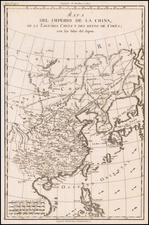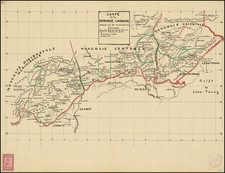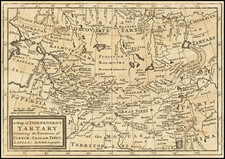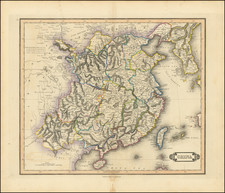Fine map of the Chinese provinces of Canton and Hainan, centered on the Macao and Hong Kong region
Includes an elaborate, decorative title cartouche showing European and Chinese traders at work.
The map was first published in Paris in 1735 by Jean Baptiste Bourguignon D'Anville and was then re-issued in 1737 in atlas form in The Hague in the " Nouvel Atlas De La Chine". This important atlas comprised 42 new and more detailed maps than any previous atlas . It was published to accompany Pere J.B. Du Halde's " Description Geographique, Historique, Chronologique, Et Physique De L'Empire De La Chine".
Jean-Baptiste Bourguignon d’Anville (1697-1782) was one of the foremost French geographers of the eighteenth century. He carried out rigorous research in order to create his maps, which greatly developed the technical proficiency of mapmaking during his lifetime. His style was also simpler and less ornate than that of many of his predecessors. It was widely adopted by his contemporaries and successors.
The son of a tailor, d’Anville showed cartographic prowess from a young age; his first map, of Ancient Greece, was published when he was only fifteen years old. By twenty-two, he was appointed as one of the King’s géographes ordinaire de roi. He tutored the young Louis XV while in the service to the Crown. However, royal appointment did not pay all the bills, so d’Anville also did some work for the Portuguese Crown from 1724. For example, he helped to fill out Dom João V’s library with geographical works and made maps showing Portugal’s African colonies.
D’Anville disapproved of merely copying features from other maps, preferring instead to return to the texts upon which those maps were based to make his own depictions. This led him to embrace blank spaces for unknown areas and to reject names which were not supported by other sources. He also amassed a large personal map library and created a network of sources that included Jesuits in China and savants in Brazil. D’Anville’s historical approach to cartography resulted in magnificently detailed, yet modern and academic, maps. For example, his 1743 map of Italy improved upon all previous maps and included a memoir laying out his research and innovations. The geographer also specialized in ancient historical geography.
In 1773, d’Anville was named premier géographe de roi. In 1780, he ceded his considerable library to the Ministry of Foreign Affairs to be used for as a reference library for diplomats. D’Anville is best known for several maps, including his map of China, first published in 1735, and then included with Du Halde’s history of that country (the Hague, 1737). His map of Africa (1749) was used well into the nineteenth century.

![[Guandong and Hainan, China] Province De Quang-Tong By Jean-Baptiste Bourguignon d'Anville](https://storage.googleapis.com/raremaps/img/small/57106.jpg)








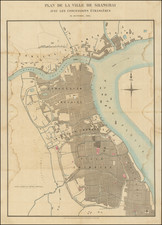
![[ Taiwan ] Die Insel Formosa neu abgemessen auf Befehl Kaysers Kamhi](https://storage.googleapis.com/raremaps/img/small/91214.jpg)
